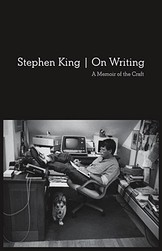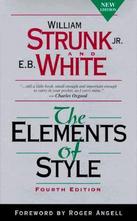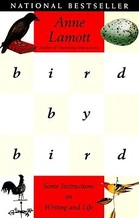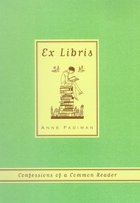
Warning: This is less a review and more an essay. It's long, quote-ridden, and spoilery (inasmuch as nonfiction can be spoiled). Also, marginalia!
There's a bit of review-breakdown at the very end, and further reading recommendations, so just scroll down if that's what you're here for.
There's a bit of review-breakdown at the very end, and further reading recommendations, so just scroll down if that's what you're here for.
| The contents of craft books (as with any of the self-help genres) are generally hit-or-miss—the advice tends to fall into one of four categories: (1) full disagreement (reader rejects writer’s idea immediately); (2) filler (reader has heard this idea before, and the writer adds nothing new to the discourse); (3) epiphany-once-removed (reader was familiar with the idea but didn’t have the words to fully express it ‘til now); and (4) true epiphany (reader has never had this idea before). Stephen King’s On Writing, at least half consisting of the author’s memoir, adds a new category: irrelevant (ideas that don’t relate to the craft the book is trying to teach). Whether this new category adds anything to the book other than a demographic of potential readers to its market… Well, that’s a matter of opinion. My opinion is a resounding No. Most of this irrelevant information is contained in the first section, “CV,” which is entirely memoir: mostly-chronological snapshots of his life. Some, yes, show his life as a writer, but the only discussion of the act of writing was done in abstractions (simply saying that he did write in every stage of his life, but not explaining how) and allegories (describing the sparks that inspired several of his major works, but not applying the stories pedagogically). Honestly, most of this section feels entirely self-congratulatory—he lists his successes, glosses over his failures, and explains his weaknesses only to make the better point that he overcame them. Not a very effective way to draw a reader into the book.[1] The most solid advice that is given in these hundred pages is that mind-altering drugs aren’t necessary for creative work, further illustrated by his assertation that you should “put your desk in the corner, and every time you sit down there to write, remind yourself why it isn’t in the middle of the room. Life isn’t a support-system for art. It’s the other way around” (101). Okay, so building a life around writing, rather than fitting writing into the routine of your life, isn’t going to end well for anyone involved. Like I said: solid advice—part of the epiphany-once-removed category. But he probably could have gotten there in a fraction of the pagecount, if he hadn’t gone into so much detail about the time he dropped a cinderblock on his toe or how he met his wife or the many years of his life was spent working in a Laundromat[2]. The “Toolbox” section is a slight improvement—and not only because it’s under half as long. Most of it is simple restatement of Strunk and White’s Elements of Style, and of those two men’s opinions on writing—the definition of the filler category—, but there are some few gems of King’s original insight. The first of these is the use of grammar—particularly very simple sentence structures—as “the pole you grab to get your thoughts up on their feet and walking” (121). As King says: Take any noun, put it with any verb, and you have a sentence. It never fails. Rocks explode. Jane transmits. Mountains float. These are all perfect sentences. Many such thoughts make little rational sense, but even the stranger ones (Plums deify!) have a kind of poetic weight that’s nice. The simplicity of noun-verb construction is useful—at the very least it can provide a safety net for your writing. Strunk and White caution against too many simple sentences in a row, but simple sentences provide a path you can follow when you fear getting lost in the tangles of rhetoric… —King 121 There’s something very freeing about being told that it’s okay to use the most basic tools to say what needs saying. In fact, the very simplicity of these tools can be used effectively—they make it easier for the reader to understand the story, and isn’t that our goal, after all? King applies this principle to more than just sentence structure, but also to using multiple sentences (pointing out “how much simpler the thought is to understand when it’s broken up into two thoughts” [124]), to simple paragraph structure (“Topic-sentence-followed-by-support-and-description insists that the writer organize his/her thoughts, and it also provides good insurance against wandering away from the topic” [131]), and to sentence fragments (“frags can also work beautifully to streamline narration, create clear images, and create tension as well as to vary the prose-line” [133]). My pointing out the virtues of more basic storytelling, he takes much of the pressure off of composition. The other useful piece of information in the “Toolbox” is King’s idea that much of what’s commonly considered sloppy writing (adverbs, vagueness, etc.) are due to the writer’s fear that “he/she isn’t expressing himself/herself clearly, that he or she is not getting the point or the picture across” (124) [3]. He ties this belief into his door open/door shut theory (that first drafts should be completed with the “door shut,” the writer alone and no interference from other people’s opinions, and that revisions with the “door open,” the writer researching unknown details and inviting others to read the work), drawing a distinction between the writer’s fear with the door closed and with it open: “If one is writing for one’s own pleasure, that fear may be mild--timidity is the word I’ve used here. If, however, one is working under deadline … that fear may be intense” (127). Finally--finally—King gets to the meat of the issue in the “On Writing” section of the book of that title. Now that he’s introduced his life history to us and re-introduced basic concepts of style and grammar, he starts talking about how writing actually works. He goes into detail on topics ranging from the generality of a writing space (“it really needs only one thing: a door which you are willing to shut” [155]) and time (“Don’t wait for the muse. … Your job is to make sure the muse knows where you’re going to be every day from nine ‘til noon or seven ‘til three. If he does know, I assure you that sooner or later he’ll start showing up, chomping his cigar and making his magic” [157]) to the specific problems of over-describing (“if I describe [my visualization], it freezes out yours, and I lose a little bit of the bond of understanding I want to forge between us. Description begins in the writer’s imagination, but should finish in the reader’s” [174]). He goes over revising for symbolism, theme, and pacing (“2nd Draft = 1st Draft – 10%” [222]), repeatedly encourages that writers be willing to kill their darlings (“When a novelist is challenged on something he likes—one of his darlings—the first two words out of his mouth are almost always Yeah but” [226]), and gives detailed advice on querying agents (“ask [them] for a list of their bona fides—not a list of clients…, but a list of the publishers to whom the agent had sold books and the magazines to which he had sold short stories. It’s easy to con a writer who’s desperate for representation” [147]). Every stage of the writing process is thoroughly covered, and a decent amount of the information here doesn’t receive the overkill from other craft books that the “Toolbox” section did—some of it even felt new. The newest-feeling piece—my greatest “epiphany” of the book—is King’s explanation of the weakness of plot: Stories are relics, part of an undiscovered pre-existing world. The writer’s job is to use the tools in his or her toolbox to get as much of each one out of the ground intact as possible. … No matter how good you are, no matter how much experience you have, it’s probably impossible to get the entire fossil out of the ground without a few breaks and losses. To get even most of it, the shovel must give way to more delicate tools: airhose, palm-pick, perhaps even a toothbrush. Plot is a far bigger tool, the writer’s jackhammer. You can liberate a fossil from hard ground with a jackhammer, no argument there, but you know as well as I do that the jackhammer is going to break almost as much stuff as it liberates. It’s clumsy, mechanical, anticreative. Plot is, I think, the good writer’s last resort and the dullard’s first choice. The story which results from it is apt to feel artificial and labored. —King 163-4 This idea—that a story is a found object, and that the writer uncovers the situation first and needs to discover the rest without succumbing to any predisposed notions of what the story should be—is downright revelatory to me. Not only does it have obvious repercussions in the suspense and tension of the finished product: “if I’m not able to guess with any accuracy how the damned thing is going to turn out, even with my inside knowledge of coming events, I can be pretty sure of keeping the reader in a state of page-turning anxiety” (165), but it is also amazingly liberating for both the writer and the story. It’s this liberating tone that is laced throughout the book, and that is its real value—encouraging the writer to take the story wherever it wants to go. Don’t worry overmuch about sentence structure and rhetoric; don’t be afraid of readers not understanding what you mean; don’t think about plot or symbolism; and most importantly, don’t let anything stop your writing. The story is a relic; while you’re pulling it from the ground, your focus needs to be on keeping it as close to whole as possible, and the dirt and stains aren’t your concern. Anything too atrocious can be fixed or cut in a later draft—“Certainly I couldn’t keep it in on the grounds that it’s good; it should be good, if I’m being paid to do it. What I’m not being paid to do is be self-indulgent” (178)[4]. For now, just put words to page until you hit The End. King ends the book by breaking it down into three parts: Some of this book—perhaps too much—has been about how I learned to do it. Much of it has been about how you can do it better. The rest of it—and perhaps the best of it—is a permission slip: you can, you should, and if you’re brave enough to start, you will. —King 270 I think that King’s evaluation is entirely accurate—for a writing book, it has an overabundance of retrospection, a solid amount of advice, and a particularly valuable tone of authorization.[5] But those last two things make for 150 pages of very necessary reading-about-writing.[6] | [1] At least, not a reader who has picked it up for the craft it claims to teach. A friend who read it as a memoir, looking to find out more about King himself, didn’t have this problem with it. [2] Much of the blame for my low opinion of this section may lie in my own impatience to get to what I consider the more relevant parts. Surprise, this review is biased! [3] I would say the same of King’s awkward use of “he/she” (and its variations), that he is afraid of angering some politically-corrective reader. It is especially irritating here because it isn’t pervasive throughout the rest of the book, where he does use masculine pronouns to generalize. Pick one style or the other, Mr. King—don’t spend a couple of paragraphs mincing about and then the other 300 pages clomping as usual. [4] Personally, I find this a bit hypocritical, as I believe that at least 25% of this book could have been cut at no loss. Seeing this as a do-as-I-say moment. [5] Why, if King saw this imbalance during the writing and revising processes (which he must have, since he ends the book by stating it) does he not edit the memoir sections down, or at least ensure that each adds something significant to the reader’s understanding of craft? The world may never know. [6] …and only about 140 of reading-about-writer. |
Review:
For all that the craft parts of this book are some of the best I've read (4-5 stars), they're so outweighed by unrelated bits and pieces that I can only give this, as a craft book, 3 stars.
Recommendations:

The Elements of Style,
by William Strunk Jr. and E.B. White
If you're a writer and you haven't read this, then drop your pen right now and pick up a copy of this book.
It's the definitive guide on writing decent prose.
You don't have to agree with these guys, but you
need to at least know what their standards are.
(King makes reference to this book a lot.)

Bird By Bird, by Anne Lamott
A similar vein of books-on-the-writer's-life.
(This one wasn't for me, but mainly because I
didn't agree much with her opinions -- she's
clearly speaking for a more "literary" writer.)
Lamott weaves her writing into her personal
accounts much more seamlessly than King does.

Ex Libris, by Anne Fadiman
If you're looking for something more along the
lines of a literary-themed memoir (which I
clearly was not when I read On Writing),
then you should pick this one up.
It's a warm little love letter to every
aspect of bibliophilia, with sections on
everything from rearranging your library
to collecting obscure vocab. Very enjoyable.
If you're looking for something more along the
lines of a literary-themed memoir (which I
clearly was not when I read On Writing),
then you should pick this one up.
It's a warm little love letter to every
aspect of bibliophilia, with sections on
everything from rearranging your library
to collecting obscure vocab. Very enjoyable.

 RSS Feed
RSS Feed